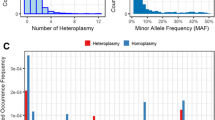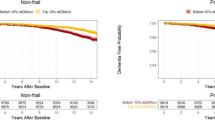Abstract
Mitochondrial function is altered with age and variants in mitochondrial DNA (mtDNA) modulate risk for several age-related disease states. However, the association of mtDNA copy number, a readily available marker which reflects mitochondrial depletion, energy reserves, and oxidative stress, on aging and mortality in the general population has not been addressed. To assess the association between mtDNA copy number and two primary outcomes—prevalent frailty and all-cause mortality—we utilize data from participants who were from two multicenter, multiethnic, community-based, prospective studies—the Cardiovascular Health Study (CHS) (1989–2006) and the Atherosclerosis Risk in Communities (ARIC) study (1987–2013). A total of 4892 participants (43.3 % men) from CHS and 11,509 participants (44.9 % men) from ARIC self-identifying as white or black were included in the analysis. mtDNA copy number, the trait of interest, was measured using a qPCR-based method in CHS and an array-based method in ARIC from DNA isolated from whole blood in participants from both cohorts. In race-stratified meta-analyses, we observe a significant inverse association of mtDNA copy number with age and higher mtDNA copy number in women relative to men. Lower mtDNA copy number was also significantly associated with prevalent frailty in white participants from CHS (OR 0.91, 95 % CI 0.85–0.97). Additionally, mtDNA copy number was a strong independent predictor of all-cause mortality in an age- and sex-adjusted, race-stratified analysis of 16,401 participants from both cohorts with a pooled hazard ratio of 1.47 (95 % CI 1.33–1.62) for the lowest quintile of mtDNA copy number relative to the highest quintile.
Key messages
-
Mitochondrial DNA (mtDNA) copy number is associated with age and sex.
-
Lower mtDNA copy number is also associated with prevalent frailty.
-
mtDNA copy number is a significant predictor of all-cause mortality in a multiethnic population.



Similar content being viewed by others
References
Ernster L, Low H, Nordenbrand K, Ernster B (1955) A component promoting oxidative phosphorylation, released from mitochondria during aging. Exp Cell Res 9:348–349
Honjo I, Ozawa K, Kitamura O et al (1968) Rapid change of phospholipid in pancreas mitochondria during aging. J Biochem (Tokyo) 64:311–320
Harman D (1972) The biologic clock: the mitochondria? J Am Geriatr Soc 20:145–147
Conley KE, Jubrias SA, Esselman PC (2000) Oxidative capacity and ageing in human muscle. J Physiol 526(Pt 1):203–210
Petersen KF, Befroy D, Dufour S et al (2003) Mitochondrial dysfunction in the elderly: possible role in insulin resistance. Science 300:1140–1142
Cui H, Kong Y, Zhang H (2011) Oxidative stress, mitochondrial dysfunction, and aging. J Signal Transduct. doi:10.1155/2012/646354
Chan DC (2006) Mitochondria: dynamic organelles in disease, aging, and development. Cell 125:1241–1252
Kabekkodu SP, Bhat S, Mascarenhas R et al (2013) Mitochondrial DNA variation analysis in cervical cancer. Mitochondrion. doi:10.1016/j.mito.2013.07.001
Liou C-W, Chen J-B, Tiao M-M et al (2012) Mitochondrial DNA coding and control region variants as genetic risk factors for type 2 diabetes. Diabetes 61:2642–2651
Kenney MC, Hertzog D, Chak G et al (2013) Mitochondrial DNA haplogroups confer differences in risk for age-related macular degeneration: a case control study. BMC Med Genet 14:4
Kujoth GC, Hiona A, Pugh TD et al (2005) Mitochondrial DNA mutations, oxidative stress, and apoptosis in mammalian aging. Science 309:481–484
Trifunovic A, Wredenberg A, Falkenberg M et al (2004) Premature ageing in mice expressing defective mitochondrial DNA polymerase. Nature 429:417–423
Lezi E, Swerdlow RH (2012) Mitochondria in neurodegeneration. Adv Exp Med Biol 942:269–286
DuBoff B, Feany M, Götz J (2013) Why size matters – balancing mitochondrial dynamics in Alzheimer’s disease. Trends Neurosci 36:325–335
Gaweda-Walerych K, Zekanowski C (2013) Integrated pathways of parkin control over mitochondrial maintenance - relevance to Parkinson’s disease pathogenesis. Acta Neurobiol Exp (Warsz) 73:199–224
Van der Walt JM, Nicodemus KK, Martin ER et al (2003) Mitochondrial polymorphisms significantly reduce the risk of Parkinson disease. Am J Hum Genet 72:804–811
Van der Walt JM, Dementieva YA, Martin ER et al (2004) Analysis of European mitochondrial haplogroups with Alzheimer disease risk. Neurosci Lett 365:28–32
Hudson G, Nalls M, Evans JR et al (2013) Two-stage association study and meta-analysis of mitochondrial DNA variants in Parkinson disease. Neurology 80:2042–2048
Thyagarajan B, Wang R, Nelson H et al (2013) Mitochondrial DNA copy number is associated with breast cancer risk. PLoS ONE 8:e65968
Moore AZ, Biggs ML, Matteini A et al (2010) Polymorphisms in the mitochondrial DNA control region and frailty in older adults. PLoS ONE 5:e11069
Fried LP, Tangen CM, Walston J et al (2001) Frailty in older adults: evidence for a phenotype. J Gerontol A Biol Sci Med Sci 56:M146–M156
Clay Montier LL, Deng JJ, Bai Y (2009) Number matters: control of mammalian mitochondrial DNA copy number. J Genet Genomics Yi Chuan Xue Bao 36:125–131
Liu JC, Tsai JC, Kuo JC et al (2003) Oxidative stress-related alteration of the copy number of mitochondrial DNA in human leukocytes. Free Radic Res 37:1307–1317
Welle S, Bhatt K, Shah B et al (2003) Reduced amount of mitochondrial DNA in aged human muscle. J Appl Physiol 94:1479–1484
Hebert SL, Lanza IR, Nair KS (2010) Mitochondrial DNA alterations and reduced mitochondrial function in aging. Mech Ageing Dev 131:451–462
Short KR, Bigelow ML, Kahl J et al (2005) Decline in skeletal muscle mitochondrial function with aging in humans. Proc Natl Acad Sci U S A 102:5618–5623
Fried LP, Borhani NO, Enright P et al (1991) The cardiovascular health study: design and rationale. Ann Epidemiol 1:263–276
Psaty BM, Kuller LH, Bild D et al (1995) Methods of assessing prevalent cardiovascular disease in the cardiovascular health study. Ann Epidemiol 5:270–277
Investigators TA (1989) The atherosclerosis risk in communit (Aric) stui)y: design and objectwes. Am J Epidemiol 129:687–702
ARIC carotid MRI study investigators atheroschlerosis risk in communities carotid MRI study, Manual 7 DNA Determinations
Fleishman JA, Selim AJ, Kazis LE (2010) Deriving SF-12v2 physical and mental health summary scores: a comparison of different scoring algorithms. Qual Life Res Int J Qual Life Asp Treat Care Rehabil 19:231–241
Korn JM, Kuruvilla FG, McCarroll SA et al (2008) Integrated genotype calling and association analysis of SNPs, common copy number polymorphisms and rare CNVs. Nat Genet 40:1253–1260
Mar JC, Kimura Y, Schroder K et al (2009) Data-driven normalization strategies for high-throughput quantitative RT-PCR. BMC Bioinforma 10:110
Amorim RO and LD (2013) prLogistic: estimation of prevalence ratios using logistic models.
Arking DE, Reinier K, Post W et al (2010) Genome-wide association study identifies GPC5 as a novel genetic locus protective against sudden cardiac arrest. PLoS ONE 5:e9879
Mengel-From J, Thinggaard M, Dalgård C et al (2014) Mitochondrial DNA copy number in peripheral blood cells declines with age and is associated with general health among elderly. Hum Genet 133:1149–1159
Lee J-W, Park KD, Im J-A et al (2010) Mitochondrial DNA copy number in peripheral blood is associated with cognitive function in apparently healthy elderly women. Clin Chim Acta 411:592–596
Kim M-Y, Lee J-W, Kang H-C et al (2011) Leukocyte mitochondrial DNA (mtDNA) content is associated with depression in old women. Arch Gerontol Geriatr 53:e218–e221
Kington RS, Smith JP (1997) Socioeconomic status and racial and ethnic differences in functional status associated with chronic diseases. Am J Public Health 87:805–810
Acknowledgments
This work was supported by the Johns Hopkins University Claude D. Pepper Older Americans Independence Center, National Institute on Aging, P30-AG021334.
The Atherosclerosis Risk in Communities Study is carried out as a collaborative study supported by National Heart, Lung, and Blood Institute contracts (HHSN268201100005C, HHSN268201100006C, HHSN268201100007C, HHSN268201100008C, HHSN268201100009C, HHSN268201100010C, HHSN268201100011C, and HHSN268201100012C), R01HL087641, R01HL59367, and R01HL086694; National Human Genome Research Institute contract U01HG004402; and National Institutes of Health contract HHSN268200625226C. The authors thank the staff and participants of the ARIC study for their important contributions. Infrastructure was partly supported by Grant Number UL1RR025005, a component of the National Institutes of Health and NIH Roadmap for Medical Research.
This research was supported by contracts HHSN268201200036C, HHSN268200800007C, N01 HC55222, N01HC85079, N01HC85080, N01HC85081, N01HC85082, N01HC85083, N01HC85086, and grant HL080295 from the National Heart, Lung, and Blood Institute (NHLBI), with additional contribution from the National Institute of Neurological Disorders and Stroke (NINDS). Additional support was provided by AG023629 from the National Institute on Aging (NIA). A full list of principal CHS investigators and institutions can be found at CHS-NHLBI.org.
The funding agencies had no role in the design and conduct of the study, in the collection, analysis, and interpretation of the data, and in the preparation, review, or approval of the manuscript.
Conflict of interest
FNA, AM, and DEA declare that a US Patent Application relating to the use of mtDNA as a biomarker has been filed and is pending, on behalf of The Johns Hopkins University. All other authors declare no financial, personal, or professional conflicts of interest.
Disclaimer
The content is solely the responsibility of the authors and does not necessarily represent the official views of the National Institutes of Health.
Author information
Authors and Affiliations
Corresponding author
Additional information
Foram N. Ashar and Anna Moes contributed equally to this article.
Electronic supplementary material
Below is the link to the electronic supplementary material.
ESM 1
(PDF 167 kb)
Rights and permissions
About this article
Cite this article
Ashar, F.N., Moes, A., Moore, A.Z. et al. Association of mitochondrial DNA levels with frailty and all-cause mortality. J Mol Med 93, 177–186 (2015). https://doi.org/10.1007/s00109-014-1233-3
Received:
Accepted:
Published:
Issue Date:
DOI: https://doi.org/10.1007/s00109-014-1233-3




